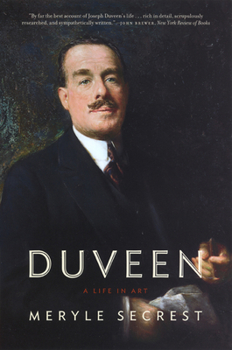Duveen: A Life in Art
Select Format
Select Condition 
Book Overview
Anyone who has admired Gainsborough's Blue Boy of the Huntington Collection in California, or Rembrandt's Aristotle Contemplating the Bust of Homer at the Metropolitan Museum of Art in New York owes much of his or her pleasure to art dealer Joseph Duveen (1869-1939). Regarded as the most influential--or, in some circles, notorious--dealer of the twentieth century, Duveen established himself selling the European masterpieces of Titian, Botticelli, Giotto, and Vermeer to newly and lavishly wealthy American businessmen--J. P. Morgan, John D. Rockefeller, and Andrew Mellon, to name just a few. It is no exaggeration to say that Duveen was the driving force behind every important private art collection in the United States. The first major biography of Duveen in more than fifty years and the first to make use of his enormous archive--only recently opened to the public--Meryle Secrest's Duveen traces the rapid ascent of the tirelessly enterprising dealer, from his humble beginnings running his father's business to knighthood and eventually apeerage. The eldest of eight sons of Jewish-Dutch immigrants, Duveen inherited an uncanny ability to spot a hidden treasure from his father, proprietor of a prosperous antiques business. After his father's death, Duveen moved the company into the riskier but lucrative market of paintings and quickly became one of the world's leading art dealers. The key to Duveen's success was his simple observation that while Europe had the art, America had the money; Duveen made his fortune by buying art from declining European aristocrats and selling them to the "squillionaires" in the United States. "By far the best account of Joseph Duveen's life in a biography that is rich in detail, scrupulously researched, and sympathetically written. Secrest's] inquiries into early-twentieth-century collecting whet our appetite for a more general history of the art market in the first half of the twentieth century."--John Brewer, New York Review of Books
Format:Paperback
Language:English
ISBN:0226744159
ISBN13:9780226744155
Release Date:November 2005
Publisher:University of Chicago Press
Length:540 Pages
Weight:2.10 lbs.
Dimensions:1.6" x 6.3" x 9.3"
Customer Reviews
3 ratings
enthralling biography of master art salesman
Published by Thriftbooks.com User , 15 years ago
This is one of the most enthralling biographies that I have read. In fact I have read it twice and will probably return to it in the future! Duveen was such an interesting character and he was associated with an equally fascinating array of rich and famous personalities. Reading about his flamboyant style and his often questionable sales tactics makes one realise that he was one of a kind. If you are interested in the history of art collecting, art in general or just looking for a ripping yarn, you should enjoy Secrest's biography. The book is well researched and the writing style is very readable. Interested readers are also urged to investigate S.N Behrman's book on Duveen. Originally published in the New Yorker in the early fifties, it charmingly complements Secrest's biography.
although somehow difficult to follow, very interesting book
Published by Thriftbooks.com User , 18 years ago
For someone interested in art, and more particulary in paintings, this is a very interesting book. Perhaps too many dates, too many names all mixed up in the course of some 40 or 50 years. However, i think it is the best the author could have done. Full of anecdotes, reading this book is also a very entertaining way of learning about the world of art dealers, auction firms and the greatest collectors of all time. Very recommendable
Europe had the Art, America had the Money
Published by Thriftbooks.com User , 20 years ago
The sub-title of this book, 'A Life in Art' is absolutely true, but almost misleading. Quite a number of books with something like that in their name deal with the life of an artist. This one, instead, deals with the life of Joseph Duveen, art dealer. Joseph Duveen lived at a time when the established order was changing. He made an early observation that while Europe had the art, America had the money. As head of Duveen Brothers (London, Paris, New York) he set up an organization finding hundreds of the Old Masters in Europe and selling them to American collecters. The list of his customers reads like a Who's Who of the American rich: Mellon, Frick, J. P. Morgan, Huntington, Kress, Hearst and many, many more. The book is largely based on the Duveen Archive. Held by the Metropolitan Museum of Art in New York, the archive was locked away and hidden. Only recently has the archive been transferred to the Getty Research Institute for the History of Art and the Humanities in Los Angeles. There a decision was made to make the archive available on microfilm for study. The archive consists of the documentation that accompanied the business: letters, cables, photo albums, ledgers, sales books, stock books, etc. These kinds of documents are the life blood of a business and in this case enable the author to have unparalleled insight to how the business operated. This is combined with a knac for story telling that makes the dead business documents come alive.






